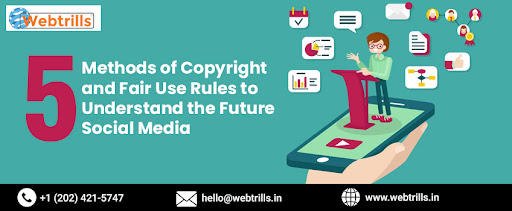
5 Methods of Copyright and Fair Use Rules to Understand the Future Social Media
The rise of social media has revolutionized the way we consume and share information. With millions of users creating and sharing content daily, the issue of copyright and fair use has become increasingly important. Copyright laws exist to protect the rights of creators and prevent unauthorized use of their work. However, in the dynamic world of social media, navigating these laws can be complex. This article by our social media optimization company in Delhi will explore five essential methods of copyright and fair use rules that individuals and businesses need to understand to ensure compliance and ethical content sharing on social media platforms.
Importance of Using Fair Use Rules in Social Media
In the fast-paced world of social media, where content is constantly created and shared, understanding and implementing fair use rules is of utmost importance. Fair use is a legal doctrine that allows for the limited use of copyrighted material without the permission of the copyright holder. Here are some key reasons why using fair use rules in social media is crucial:
1) Promotes Freedom of Expression: Fair use provides a balance between copyright protection and freedom of expression. It allows individuals and businesses to use copyrighted material for purposes such as criticism, commentary, news reporting, teaching, and research. By incorporating fair use, social media users can engage in meaningful discussions, express their opinions, and contribute to public discourse.
2) Encourages Creativity and Innovation: Fair use fosters creativity and innovation by enabling artists, content creators, and social media users to build upon existing works. It allows for the creation of transformative content, such as parodies, remixes, and mashups. These forms of creative expression often rely on the fair use exception to copyright law, allowing for the reinterpretation and reimagining of copyrighted material in new and innovative ways.
3) Facilitates Educational and Research Purposes: Social media platforms are widely used for educational and research purposes. Fair use enables educators, students, and researchers to incorporate copyrighted material into their work, such as presentations, papers, and reports. It allows for the inclusion of relevant excerpts, images, or videos to support their arguments, enhance learning experiences, and foster a deeper understanding of the subject matter.
4) Promotes Social Commentary and News Reporting: Social media has become an integral platform for social commentary, news reporting, and public awareness campaigns. Fair use enables users to share and comment on copyrighted material in order to shed light on important issues, raise awareness, and contribute to public dialogue. It allows for the dissemination of news articles, images, and videos to inform and educate the public about significant events and topics.
5) Supports Parody and Satire: Parody and satire play a vital role in social commentary and cultural criticism. Fair use protects the rights of creators to use copyrighted material for the purpose of parody or satire, allowing them to create humorous or critical works that often rely on the use of recognizable elements from copyrighted works. This form of expression adds diversity, entertainment, and social commentary to the social media landscape.
Role of Using Copyright
Using copyright is crucial for protecting the rights of creators and content owners. The role of using copyright are:
1) Legal Protection: Copyright provides legal protection for original works, including literary, artistic, musical, and digital creations. It grants exclusive rights to the creator, preventing others from using, reproducing, or distributing the work without permission.
2) Ownership Rights: Copyright establishes ownership rights, allowing creators to control how their works are used, distributed, and monetized. It ensures that creators receive recognition and financial benefits from their creations.
3) Economic Incentive: Copyright serves as an economic incentive for creators by providing them with the opportunity to earn income from their works. By granting exclusive rights, copyright encourages investment in creative endeavors and stimulates innovation and creativity.
4) Content Protection: Copyright helps protect content from unauthorized use, copying, or plagiarism. It allows creators to enforce their rights and take legal action against infringers, ensuring that their work is not exploited without permission.
5) Cultural Preservation: Copyright plays a role in preserving cultural heritage and promoting diversity. It encourages the creation and preservation of cultural expressions, literature, music, and art forms, allowing for the continuation of cultural traditions and the promotion of cultural identity.
6) Licensing and Collaboration: Copyright facilitates licensing agreements, allowing creators to grant permissions for the use of their works in exchange for royalties or fees. It enables collaboration between creators, businesses, and organizations, fostering the creation of new works and expanding artistic and creative opportunities.
7) Incentive for Creativity: Copyright provides an incentive for creators to invest time, effort, and resources in the creation of original works. It rewards innovation and encourages individuals to express their ideas and talents, contributing to the enrichment of society.
8) Protection of Moral Rights: Copyright protects the moral rights of creators, including the right to be attributed as the author of a work and the right to integrity. It ensures that creators are recognized for their contributions and that their works are not distorted or modified in ways that may harm their reputation.
Methods of Fair Use and Copyright
1) Familiarize Yourself with Copyright Basics: Understanding the fundamentals of copyright is crucial in the social media landscape. Copyright grants exclusive rights to creators, including the rights to reproduce, distribute, display, and create derivative works from their original content. When using social media platforms, it's essential to recognize that the act of uploading or sharing content does not automatically grant permission to use copyrighted material. Users should seek permission or ensure their use falls within the scope of fair use.
2) Fair Use Doctrine and Its Application: Fair use is a legal doctrine that allows limited use of copyrighted material without permission from the copyright owner. Fair use is determined on a case-by-case basis and considers various factors, such as the purpose and character of the use, the nature of the copyrighted work, the amount used, and the potential impact on the market for the original work. While fair use provides some flexibility, it's crucial to understand that it is not a blanket defense for using copyrighted material.
3) Obtain Proper Licenses and Permissions: To ensure compliance with copyright laws, it is advisable to obtain proper licenses and permissions when using copyrighted material in social media posts. This includes securing licenses for images, music, videos, or any other copyrighted content that may be used in your posts. Many stock photo websites and music platforms offer licensing options for commercial use, making it easier to access and use content legally.
4) Create and Share Original Content: One of the best ways to avoid copyright issues on social media is by creating and sharing original content. By producing your own images, videos, and written material, you retain full control and ownership. Original content not only helps you avoid infringing on someone else's copyright but also adds value and uniqueness to your social media presence.
5) Provide Attribution and Give Credit: When using copyrighted material under fair use or with permission, it is crucial to provide proper attribution and give credit to the original creator. Including the source or creator's name in your social media posts not only demonstrates respect for their work but also helps you comply with ethical standards and copyright guidelines.
Conclusion
As social media continues to evolve, understanding copyright and fair use rules is essential for individuals and businesses alike. By familiarizing ourselves with the basics of copyright, understanding fair use principles, obtaining licenses and permissions when necessary, creating original content, and providing proper attribution, we can navigate the complex world of social media while respecting the rights of content creators. Compliance with copyright laws not only protects us from legal consequences but also fosters a culture of respect and collaboration in the digital realm. By following these five methods, we can ensure a future for social media that is ethical, respectful, and sustainable. For more information or to avail services of our SMO services in Delhi, visit Webtrills.in .




